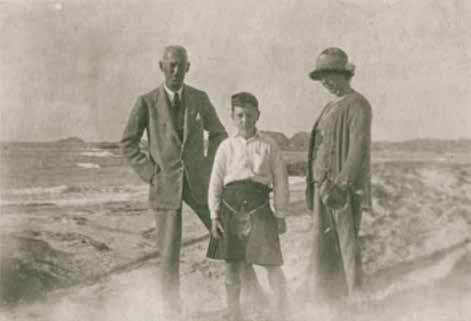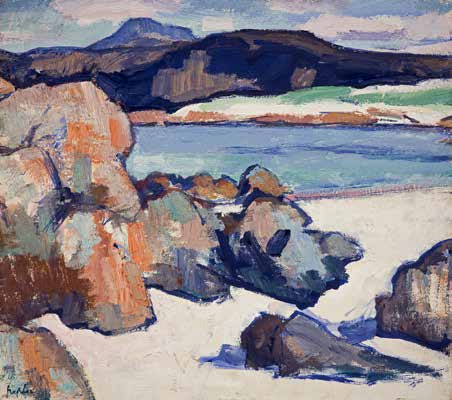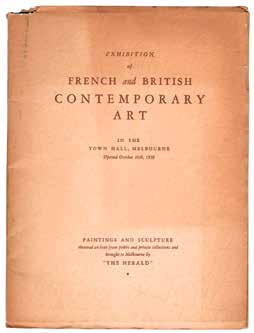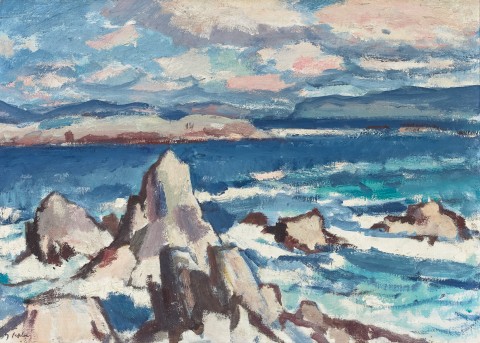A BREEZY DAY, IONA, c.1924
SAMUEL JOHN PEPLOE, R.S.A
oil on canvas
51.0 x 71.5 cm
signed lower left: S. Peploe
inscribed with artist name and title on canvas verso: BREEZY DAY / PEPLOE
bears partial label verso: PICTURES WITH CARE / Breezy Day, Iona / by
Mrs S. J. Peploe, Edinburgh, Scotland, until 1939
The Herald, Melbourne
Sir Keith Murdoch, Cruden Farm, Victoria, acquired from the above in 1939
Thence by descent
Dame Elisabeth Murdoch, Cruden Farm, Victoria
Thence by descent
Private collection, Melbourne
Memorial Exhibition of Paintings by S. J. Peploe, Royal Scottish Academy, McLellan Galleries, Glasgow, February 1937, cat. 60 (label attached verso)
Exhibition of French and British Contemporary Art, The Herald, Melbourne, opened 16 October 1939, cat. 182 (label attached verso)
Chanin, E. and Miller, S., Degenerates and Perverts: the 1939 Herald Exhibition of French and British Contemporary Art, The Miegunyah Press, Melbourne, 2005, pp. 261, 272
Cathedral Rock, Iona, 1920, oil on board, 38.2 x 45.6 cm, in the collection of Aberdeen Art Gallery and Museums, Aberdeen, Scotland
Clouds and sky, Iona, 1928, oil on canvas, 40.7 x 45.7 cm, in the collection of the Hunterian Art Gallery, University of Glasgow, Glasgow, Scotland
Iona Landscape: Rocks, c.1925-27, oil on canvas, 63.8 x 68.8 cm, in the collection of the Scottish National Gallery of Modern Art, Edinburgh, Scotland
Samuel Peploe’s A breezy day, Iona, c.1924, is one of the astonishing selection of paintings by post-impressionist and modern artists that were included in the landmark Exhibition of French and British Contemporary Art, initiated by Sir Keith Murdoch and which toured Australian venues in 1939. The curator, Basil Burdett, used his extensive personal and professional contacts alongside those provided by Murdoch to source a staggering 217 artworks by twenty-seven British and fifty-two French artists.1 Featuring paintings by such names as Van Gogh, Gauguin, Cézanne, Picasso, Matisse, Modigliani, Dali and Ben Nicholson, the dazzling exhibition attracted more than 70,000 visitors overall, with a spectacular 45,000 in Melbourne alone during its two-week tenure at that city’s Town Hall. A great number of the works were for sale at very reasonable prices but in spite of the obvious interest and excitement, particularly by the younger generation of Australian artists, the conservative State galleries balked at the opportunity and only purchased eleven relatively tame works between them.2 Their suspicion and hostility to such ‘radical’ art was best summed up by James S. McDonald, the incendiary Director of the National Gallery of Victoria, who (in)famously declared that ‘the great majority of work called ‘modern’ is the product of degenerates and perverts.’3 Murdoch, obviously, was not so resistant and purchased sixteen works from the exhibition by artists including Pierre Bonnard, Walter Sickert, Stanley Spencer, and Paul Signac. He also chose A breezy day, Iona which joined its companions at Cruden Farm, the Murdoch family home, to be enjoyed as a daily experience.
NOVL21 Cat proof 7_10_2021 B (2) (002)1.jpg

son Denis on Iona, c.1925
1871 - 1935, 2000, p. 143
Samuel Peploe is referred to as being a member of the Scottish Colourists alongside John Duncan Fergusson, Francis Cadell, and Leslie Hunter, although this term was only first used after the artist’s death. It is true that his still-lifes and other interior works were rich with post-impressionist colour but his landscapes were executed in a deliberately reduced palette, seen as early as 1903 in the painting Rocks at Barra, in the collection of the National Galleries of Scotland. Peploe commenced his formal art studies in 1893 at the age of twenty-two at the Edinburgh College of Art, before travelling the following year to Paris. Here, Peploe studied at two of the most renowned Académies, Julien and Calarossi, both of which also attracted a number of Australian artists in the same years. The more popular Académie Julien was presided over by the hugely successful academic painter William-Adolphe Bouguereau, but the Calarossi encouraged a greater freedom of expression and exposed Peploe to the work of more challenging artists such as Courbet, Manet and Cézanne. For some years he travelled between Britain and France with his lifelong friend and fellow artist, John Duncan Fergusson, painting at locations such as Étaples, Paris-Plage, Dieppe and Le Tréport. In 1900, Peploe occupied a ‘spacious but dark studio’ in Edinburgh where he ‘crafted jewel-like arrangements highlighted dramatically against dark backgrounds.’4 In 1905 he moved again, this time to a contrastingly sunny room, and his still-lifes increasingly featured a dominant white tablecloth. It is these studio works in particular that led to Peploe’s appellation as a Scottish Colourist.
NOV21 FINAL CATALOGUE_ 12_10_2021.jpg

Peploe had been exhibiting since 1896 but, by 1910, his work began attracting critical attention in London. He married that same year, moving with his bride to Paris and occupying an apartment near the Luxembourg Gardens. Despite returning to Edinburgh two years later, the French influence on his painting remained strong throughout his subsequent career. Around this time, Peploe – and his colleague Francis Cadell – developed a technique whereby the excess oil from their paint was leached out onto blotting paper before application, resulting in the dry, chalky texture seen in A breezy day, Iona. In 1920, Cadell introduced his colleague to this remote and rugged island, located off the south-western tip of Mull in the Inner Hebrides of Scotland. Peploe was entranced and would return regularly to Iona for summer holidays until his death. He preferred to paint at the northern end of the tiny island where the ‘merest shift of viewpoint of a few degrees (offers) a vista of new and perfect charms.’5 Iona possesses some extraordinary rock formations of sedimentary sandstone laid down in the Torridonian Era (1,200-544 million years ago), and at the centre of Peploe’s painting is one such pointed stack which he and Cadell christened ‘Cathedral Rock.’ This features in a number of the artist’s Iona paintings and is shown here near to high tide on a blustery day. However, in spite of the suggestive ‘breezy’ title of the painting, the summer of 1923 was quite challenging with Peploe observing that 'we had miserable weather in Iona this year – worst in living memory – gales and rain the whole time. I got very little done. But that kind of weather suits Iona; the rocks and distant shores seen through falling rain, veil behind veil, take on an elusive, mysterious quality, and when the light shines through one has visions of rare beauty.’6
NOV21 FINAL CATALOGUE_ 12_10_2021.jpg

1. Two extra works were shown alongside the 215 listed in the catalogue.
2. Another seven were purchased by State Galleries in the years after the exhibition, at much increased prices.
3. J.S. McDonald, October 1939 cited in Chanin, E. and Miller, S., Degenerates and Perverts: the 1939 Herald exhibition of French and British contemporary art, Melbourne University Publishing, 2005, pp. 229-230.
4. Gott, T., Benson, L., and Mathieson, S., Modern Britain 1900 – 1960: masterworks from Australian and New Zealand collections, exhibition catalogue, National Gallery of Victoria, Melbourne, 2007, p. 28.
5. Cadell and Peploe on Iona, The Scottish Gallery, Edinburgh, 2014. www.scottish-gallery.co.uk/iona, viewed 7 October 2021
6. Samuel Peploe, letter to William MacDonald, November 1923. See S. Cursiter, S., Peploe, Thomas Nelson, London, 1947, p. 71
ANDREW GAYNOR
